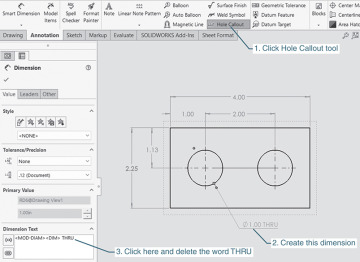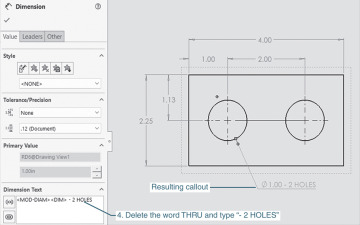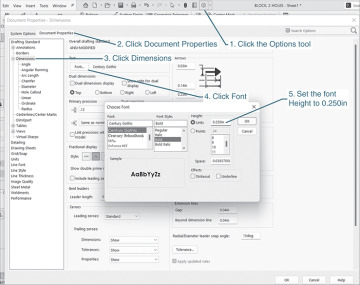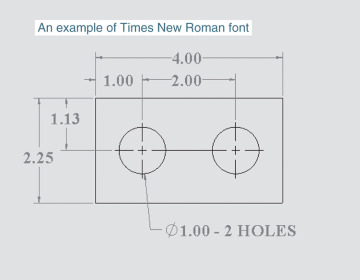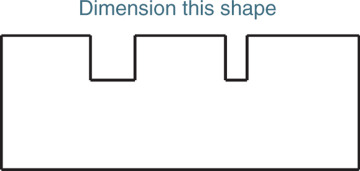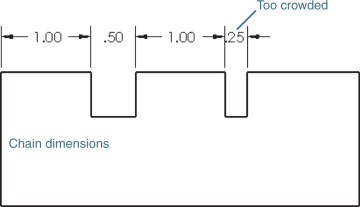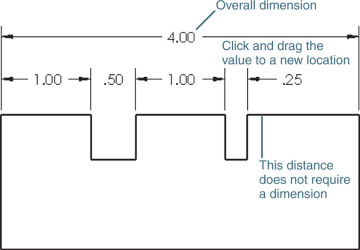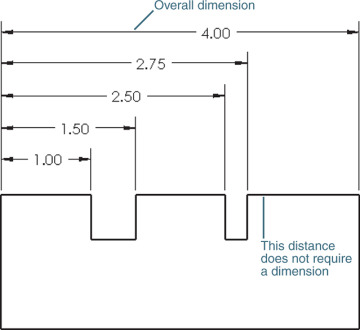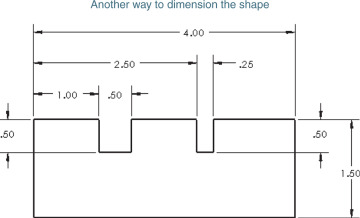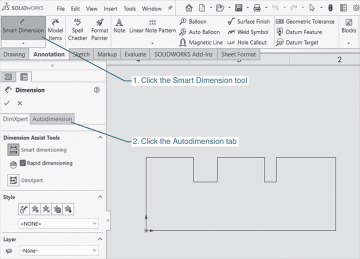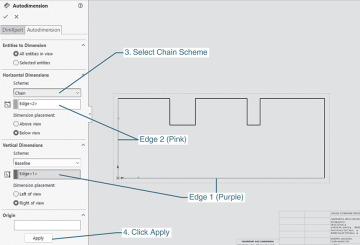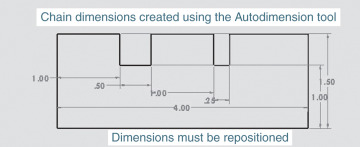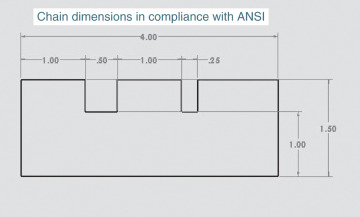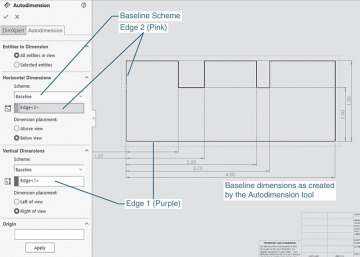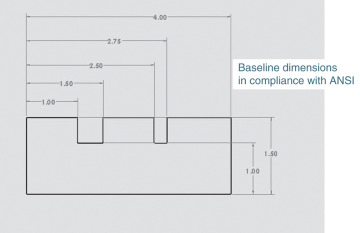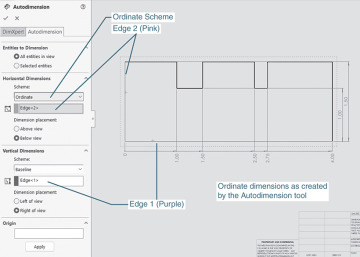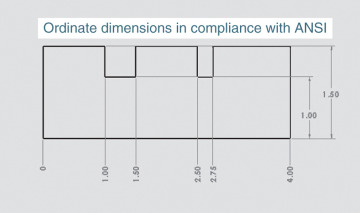- 7-1 Introduction
- 7-2 Terminology and Conventions-ANSI
- 7-3 Adding Dimensions to a Drawing
- 7-4 Drawing Scale
- 7-5 Units
- 7-6 Dimensioning Holes and Fillets
- 7-7 Dimensioning Counterbored and Countersunk Holes
- 7-8 Angular Dimensions
- 7-9 Ordinate Dimensions
- 7-10 Baseline Dimensions
- 7-11 Locating Dimensions
- 7-12 Fillets and Rounds
- 7-13 Rounded Shapes-Internal
- 7-14 Rounded Shapes-External
- 7-15 Irregular Surfaces
- 7-16 Polar Dimensions
- 7-17 Chamfers
- 7-18 Symbols and Abbreviations
- 7-19 Symmetrical and Centerline Symbols
- 7-20 Dimensioning to a Point
- 7-21 Dimensioning Section Views
- 7-22 Dimensioning Orthographic Views
- Chapter Projects
7-3 Adding Dimensions to a Drawing
Figure 7-5 shows a part that includes two holes. This section will explain how to add dimensions to the part. The part was drawn as a Part document and saved as BLOCK, 2 HOLES. See Figure 7-10 for the part’s dimensions. The part is 0.50 thick. Save the part and start a new Drawing document.
1 Click New, Drawing, and OK to start a new drawing. Use a B (ANSI) Landscape sheet size.
2 Click the View Layout tab, Model View, and create a top view of the BLOCK, 2 HOLES part.
In this example we will work with only one view. See Figure 7-6.
Extend the horizontal center mark from the left hole to the horizontal centerline of the right hole.
3 Click the horizontal centerline of the left hole. Small blue boxes will appear on the center mark.
4 Click and drag the horizontal centerline from the left hole to the right hole.
The holes now have the same horizontal centerline so only one vertical dimension can be used to define the hole’s location. See Figure 7-7.
5 Use the Smart Dimension tool and add the horizontal and vertical dimensions as shown.
See Figure 7-8.
Note that the dimension values for the vertical dimensions are written horizontally. This is in compliance with ANSI standards. For this example, the Century Gothic font was made bold with 14-point height.
6 Click the Hole Callout tool located on the Annotation panel, click the edge of the left hole, and move the cursor away from the hole.
Note that the leader arrow always points to the center of the hole.
7 Select a location off the surface of the part and click the mouse.
See Figure 7-9. The word THRU is optional. Some companies require it and some do not.
8 Go to the Dimension PropertyManager at the left of the screen, locate the cursor in the Dimension Text box, and delete the word THRU.
The text already in the box defines the hole’s diameter.
9 Move the cursor to the end of the existing text line, and type - 2 HOLES.
10 Click the green OK check mark.
Move the dimensions if needed to create neat, uniform dimensions.
See Figure 7-10.
11 Save the drawing.
Controlling Dimensions
Various aspects of dimensions can be edited, such as text height, arrow location, and text values.
1 Click the Options tool at the top of the screen.
The Documents Properties - Drafting Standard dialog box will appear. See Figure 7-11.
2 Click the Document Properties tab.
3 Click the Dimensions option.
The Document Properties - Dimensions dialog box can be used to edit the style and form of dimensions. It can also be used to change the way arrows are applied.
4 Click the Font option.
The Choose Font dialog box will appear. See Figure 7-11. This dialog box can be used to change the font, font style, and height of dimension text. The height of text can be measured in inches, millimeters, or points. A point refers to a space that equals about 1/72 of an inch. (There are 12 points to a pica.)
5 Click the Height: Units radio button and change the height to 0.250in.
Note that the SolidWorks default font is Century Gothic.
6 Click OK, then OK.
Figure 7-11 shows dimensions created using the Times New Roman font. Fonts for drawings should always be easy to read and not too stylistic.
Dimensioning Short Distances
Figure 7-12 shows an object that includes several short distances. We will start by using the standard dimensions settings and show how to edit them for a particular situation.
1 Use the Smart Dimension tool and add dimensions to the drawing.
Note that the arrows for the .50 dimension are aligned with the arrows for the 1.00 dimensions. Dimensions that are aligned in a single row are called chain dimensions. Note that the .25 dimension is crowded between the two extension lines.
There are several possible solutions to the crowded .25 value.
2 Click and drag the .25 dimension to the right outside the extension lines.
3 Add the 4.00 overall dimension.
Dimensions that define the total length and width of an object are called overall dimensions. In this example the dimension 4.00 defines the total length of the part, so it is an overall dimension. Overall dimensions are located farthest away from the edge of the part.
The right edge of the part, the section below the .25, does not need a dimension. The reason for this will be discussed in the next chapter on tolerancing.
Figure 7-12 shows two other options for dimensioning. The first is the baseline method, in which all dimensions are taken from the same datum line. The second method is a combination of chain and baseline dimensions.
Figure 7-13 shows an example of double dimensioning. The top edge distance is dimensioned twice: once using the  dimensions, and a second time using the 4.00 dimension. One of the dimensions must be omitted. Double dimensioning will be explained in more detail in Chapter 8.
dimensions, and a second time using the 4.00 dimension. One of the dimensions must be omitted. Double dimensioning will be explained in more detail in Chapter 8.
Autodimension Tool
The Autodimension tool will automatically add dimensions to a drawing.
Figure 7-14 shows a shape to be dimensioned using the Autodimension tool.
1 Click the Annotation tab, click the Smart Dimension tool, and click the Autodimension tab.
2 Select the Chain Scheme, define Edge 1 and Edge 2, click the Apply box, and click the OK check mark.
SolidWorks will automatically pick edges 1 and 2. If it does not, or the edges selected are not the ones you want, click the Edge box, then click the edge. The word Edge<1> should appear in the box.
Figure 7-14 shows the dimensions applied using the Autodimension tool. They are not in acceptable positions.
3 Rearrange the dimensions to comply with standard conventions.
Figure 7-15 shows the shape shown in Figure 7-14 dimensioned using the baseline scheme, which is created as follows.
Creating Baseline Dimensions
1 Access the Autodimension tool and select the Baseline Scheme.
2 Select Edge 1 and Edge 2.
3 Click Apply.
4 Click the green OK check mark.
Figure 7-15 shows the dimensions created by the Autodimension tool and how the dimensions can be rearranged.
Creating Ordinate Dimensions
Figure 7-16 shows the object dimensioned using the Ordinate Scheme of the Autodimension tool. The Autodimension tool did better placing the ordinate dimensions in this instance, but if some of the created dimensions are located on the surface of the part, this would be a violation of the convention that dimensions should never be located on the surface of the part. Figure 7-16 shows how the ordinate dimensions were rearranged.




